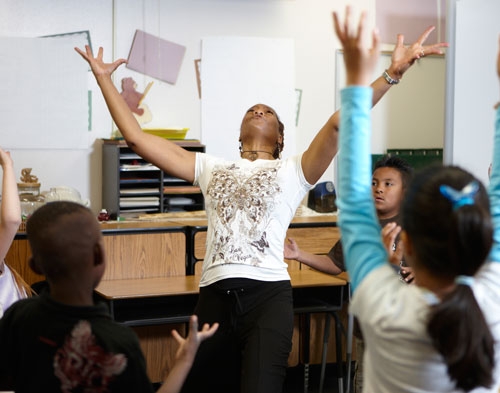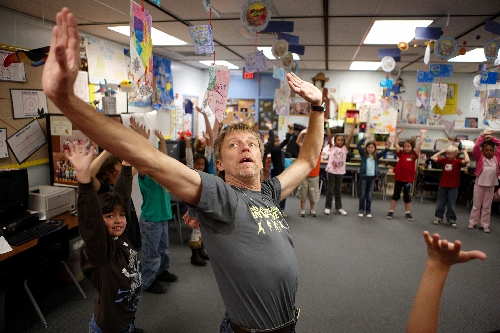Kennedy Center chooses Clark County for children’s arts program
Arts-smart and status for gratis.
Becoming the first and gaining the second is the apparent windfall for Las Vegas, with local schoolchildren reaping the riches.
That's the goal, at least, of a new project involving the Clark County School District, the Smith Center for the Performing Arts and what is widely considered America's cultural headquarters, the John F. Kennedy Center for the Performing Arts in Washington, D.C., in an essentially cost-free collaboration.
"There's the credibility and the enrichment of the Kennedy Center that brings a degree of status to Las Vegas, which is not perceived as a city with a great deal of culture," says Walt Rulffes, superintendent of the Clark County School District.
"I feel some surprise (Las Vegas was selected). I was of the opinion they would look toward more traditional cities as opposed to Las Vegas, but I appreciate that they recognized Las Vegas does have an interest in the arts."
Chosen as the fourth participating city -- joining Sacramento, Calif., Portland, Ore., and Springfield, Mo. -- Las Vegas is now part of the Kennedy Center's year-old "Any Given Child" program. The project is an effort to bulk up arts education in the United States for children in kindergarten through eighth grade by assessing current curriculum and then assisting school districts with long-term plans tailored for individual cities.
"Many cities have applied to us, 45 so far. We've studied them to see who's best prepared, and we were very impressed by the commitment of the senior leadership of Las Vegas," says Kennedy Center President Michael Kaiser. "We were thrilled to choose Las Vegas."
"Any Given Child" greatly expands on the current "Partners in Education" program in which Kennedy Center artists visit local classrooms and give workshops for teachers.
Slated to begin in late-January, "Any Given Child" works this way:
Representatives of the Kennedy Center will act as consultants to local schools and a committee of community leaders in a six- to nine-month "audit" of current arts education programs here. Based on that, the district can create a new approach that also will include local arts and youth organizations. Under construction and set for a spring 2012 opening, the Smith Center will act as an organizer.
"It's a huge issue across the country that the arts are pushed aside in that K through eight realm. Then when they get into middle school and high school, it's on an elective basis -- but the foundation they need is in K through eight," says Candy Schneider, vice president of education and community involvement for the Smith Center. The cultural complex's stages and educational facility will host performances for children, as well as opportunities for them to interact with visiting artists.
"We do have arts specialists in the elementary schools, which is tremendous. But for the arts organizations within our community, it's a wonderful opportunity to have them come together rather than work in isolation."
Partnering with local groups and combining that with existing resources and those offered by the Kennedy Center -- such as online interactive lessons and videos, and programming distributed by satellite -- the aim is to keep administrative costs low. Rulffes anticipates "relatively minor costs" if the plan that's created calls for additional resources.
"No money from Las Vegas, not one penny is coming to us," Kaiser emphasizes. "This is a national service we offer to the country. We do get a grant from the Department of Education, and we raise the rest. We're trying to come up with an approach about consistent arts education, but also an affordable arts education for each child."
Named so far to the local committee, in addition to the Smith Center and the school district: Nevada Ballet Theatre and the Las Vegas Philharmonic (both of which will move permanently into the Smith Center); Lied Discovery Children's Museum (for which a new facility is being built at the Smith Center); the city's Office of Cultural Affairs; Clark County Parks and Recreation; Rainbow Company Youth Theatre; Nevada School for the Arts; Las Vegas Youth Orchestra; After School All Stars; West Las Vegas Arts Center and Metro Arts Council of Southern Nevada.
Smaller groups such as community theaters and downtown art galleries will not be involved, at least initially. "It's not appropriate for every arts organization to have arts education," Schneider says. "Those that are interested in working with young people, that's who we are targeting. Does that mean others can't develop? Absolutely not. It's totally open."
Participating arts groups probably will be asked to work with separate grade levels. Perhaps Philharmonic personnel will instruct third-grade children about music and sound, while art museum experts handle fourth-graders' studies of other cultures and the ballet company focuses on dance history in the fifth grade.
"Youngsters from very early tots will be able to participate, and I think that changes the culture of a community," says Las Vegas Mayor Oscar Goodman, who was among local leaders meeting with Kennedy Center representatives.
"We told them the truth, how important it is to us that youngsters have a fine arts education, and with finances being the way they are, we could use as much help as we could get."
As a guiding principle for the program nationwide, Kaiser cites overcoming an inconsistent attitude by teachers toward arts education.
"If a third-grade teacher loves the arts, the children get many exposures -- going to the museum, the symphony, doing a play in class," Kaiser says. "Those same students can get to the fourth grade, and if the teacher doesn't know much about the arts or care, they get no arts exposure. If your children came back from school and said, 'We're not doing math this year because my teacher doesn't know anything about it or like it,' we wouldn't accept that."
Yet he also notes a practical consideration to an arts education, addressing the entrenched belief that, especially in recessionary times when school budgets are being slashed, arts are secondary to subjects such as math, history and English.
"We are no longer a manufacturing country. Less than 17 percent of our gross domestic product comes from manufacturing," Kaiser says. "As a result, we believe children need to be trained in problem-solving and creative skills to be able to find employment, to prepare them for the economy ahead, and the arts can play a very important role in that."
Choosing Las Vegas for "Any Given Child," Rulffes says, presages an era of change. "I think there's a new day available in Las Vegas," he says.
"There's a new Legislature, a new governor, a new superintendent, a new school board. I hope with this newness that art and culture all surface as being important, as I've placed a priority on them in the past. If I sound enthused about this, it's because I am."
Linking Las Vegas to the prestigious Kennedy Center for the Performing Arts -- facilitated by Sin City's own oncoming cultural hub at the Smith Center -- may have once been unthinkable.
Go ahead. Think it.
Contact reporter Steve Bornfeld at sbornfeld@reviewjournal.com or 702-383-0256.
























